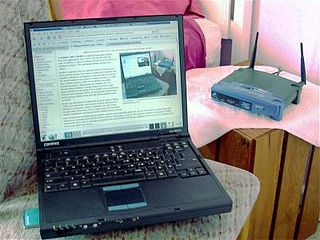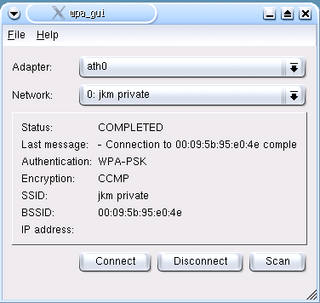Cisco Centralized Key Management (CCKM) is a form of Fast Roaming and a subset of the Cisco Compatible EXtensions (CCX) specification.
The Cisco Compatible Extensions (CCX) Specification describes a list of functional extensions to the IEEE 802.11 Wireless LAN standard to support fast roaming (CCKM) with upgraded security, reliability, and diagnostic performance. This specification is Cisco proprietary and a device manufacturer requires a Cisco license agreement in order to develop mobile devices with this technology. Currently, CCX versions 4 (CCXv4) and 5 (CCXv5) are supported.
When a wireless LAN is configured for fast reconnection, a Lightweight Extensible Authentication Protocol (LEAP) enabled client device can roam from one wireless access point to another without involving the main server. Using CCKM, an access point configured to provide Wireless Domain Services (WDS) takes the place of the RADIUS server, and authenticates the client without perceptible delay in voice or other time-sensitive applications.

A wireless LAN (WLAN) is a wireless computer network that links two or more devices using wireless communication to form a local area network (LAN) within a limited area such as a home, school, computer laboratory, campus, office building etc. This gives users the ability to move around within the area and yet still be connected to the network. Through a gateway, a WLAN can also provide a connection to the wider Internet.
The Lightweight Extensible Authentication Protocol (LEAP) is a proprietary wireless LAN authentication method developed by Cisco Systems. Important features of LEAP are dynamic WEP keys and mutual authentication. LEAP allows for clients to re-authenticate frequently; upon each successful authentication, the clients acquire a new WEP key. LEAP may be configured to use TKIP instead of dynamic WEP.

A client is a piece of computer hardware or software that accesses a service made available by a server. The server is often on another computer system, in which case the client accesses the service by way of a network.
The WDS (which can be run as a service on a Cisco Access Point or on various router modules) caches the user credentials after the initial log-on. The user must authenticate with the Radius server the first time – then he can roam between access points using cached credentials. This saves time in the roaming process, especially valuable for VoIP devices.
The current implementation of CCKM requires Cisco compatible hardware and either LEAP, EAP-FAST (CCXv3) or PEAP-GTC, PEAP-MSCHAP, EAP-TLS (CCXv4).
Remote Authentication Dial-In User Service (RADIUS) is a networking protocol, operating on port 1812 that provides centralized Authentication, Authorization, and Accounting management for users who connect and use a network service. RADIUS was developed by Livingston Enterprises, Inc. in 1991 as an access server authentication and accounting protocol and later brought into the Internet Engineering Task Force (IETF) standards.
IEEE 802.1X is an IEEE Standard for port-based Network Access Control (PNAC). It is part of the IEEE 802.1 group of networking protocols. It provides an authentication mechanism to devices wishing to attach to a LAN or WLAN.
An authentication protocol is a type of computer communications protocol or cryptographic protocol specifically designed for transfer of authentication data between two entities. It allows the receiving entity to authenticate the connecting entity as well as authenticate itself to the connecting entity by declaring the type of information needed for authentication as well as syntax. It is the most important layer of protection needed for secure communication within computer networks.
IEEE 802.11r-2008 or fast BSS transition (FT), also called fast roaming, is an amendment to the IEEE 802.11 standard to permit continuous connectivity aboard wireless devices in motion, with fast and secure handoffs from one base station to another managed in a seamless manner. It was published on July 15, 2008. IEEE 802.11r-2008 was rolled up into 802.11-2012.
The Protected Extensible Authentication Protocol, also known as Protected EAP or simply PEAP, is a protocol that encapsulates the Extensible Authentication Protocol (EAP) within an encrypted and authenticated Transport Layer Security (TLS) tunnel. The purpose was to correct deficiencies in EAP; EAP assumed a protected communication channel, such as that provided by physical security, so facilities for protection of the EAP conversation were not provided.
Extensible Authentication Protocol ('EAP') is an authentication framework frequently used in network and internet connections. It is defined in RFC 3748, which made RFC 2284 obsolete, and is updated by RFC 5247.
Xsupplicant is a supplicant that allows a workstation to authenticate with a RADIUS server using 802.1X and the Extensible Authentication Protocol (EAP). It can be used for computers with wired or wireless LAN connections to complete a strong authentication before joining the network and supports the dynamic assignment of WEP keys.

Wireless security is the prevention of unauthorized access or damage to computers or data using wireless networks, which include Wi-Fi networks. The most common type is Wi-Fi security, which includes Wired Equivalent Privacy (WEP) and Wi-Fi Protected Access (WPA). WEP is a notoriously weak security standard: the password it uses can often be cracked in a few minutes with a basic laptop computer and widely available software tools. WEP is an old IEEE 802.11 standard from 1997, which was superseded in 2003 by WPA, or Wi-Fi Protected Access. WPA was a quick alternative to improve security over WEP. The current standard is WPA2; some hardware cannot support WPA2 without firmware upgrade or replacement. WPA2 uses an encryption device that encrypts the network with a 256-bit key; the longer key length improves security over WEP. Enterprises often enforce security using a certificate-based system to authenticate the connecting device, following the standard 802.1X.
IEEE 802.11u-2011 is an amendment to the IEEE 802.11-2007 standard to add features that improve interworking with external networks.
Internet Authentication Service (IAS) is a component of Windows Server operating systems that provides centralized user authentication, authorization and accounting.
Network Admission Control (NAC) refers to Cisco's version of Network Access Control, which restricts access to the network based on identity or security posture. When a network device is configured for NAC, it can force user or machine authentication prior to granting access to the network. In addition, guest access can be granted to a quarantine area for remediation of any problems that may have caused authentication failure. This is enforced through an inline custom network device, changes to an existing switch or router, or a restricted DHCP class. A typical (non-free) WiFi connection is a form of NAC. The user must present some sort of credentials before being granted access to the network.

wpa_supplicant is a free software implementation of an IEEE 802.11i supplicant for Linux, FreeBSD, NetBSD, QNX, AROS, Microsoft Windows, Solaris, OS/2 and Haiku. In addition to being a fully featured WPA2 supplicant, it also implements WPA and older wireless LAN security protocols.

In computer networking, a supplicant is an entity at one end of a point-to-point LAN segment that seeks to be authenticated by an authenticator attached to the other end of that link. The IEEE 802.1X standard uses the term "supplicant" to refer either to hardware or to software. In practice, a supplicant is a software application installed on an end-user's computer. The user invokes the supplicant and submits credentials to connect the computer to a secure network. If the authentication succeeds, the authenticator typically allows the computer to connect to the network.
hostapd is a user space daemon software enabling a network interface card to act as an access point and authentication server. There are three implementations: Jouni Malinen's hostapd, OpenBSD's hostapd and Devicescape's hostapd.
WISPr or Wireless Internet Service Provider roaming is a draft protocol submitted to the Wi-Fi Alliance that allows users to roam between wireless internet service providers in a fashion similar to that which allows cellphone users to roam between carriers. A RADIUS server is used to authenticate the subscriber's credentials.
PANA is an IP-based protocol that allows a device to authenticate itself with a network to be granted access. PANA will not define any new authentication protocol, key distribution, key agreement or key derivation protocols. For these purposes, the Extensible Authentication Protocol (EAP) will be used, and PANA will carry the EAP payload. PANA allows dynamic service provider selection, supports various authentication methods, is suitable for roaming users, and is independent from the link layer mechanisms.
In computing, Microsoft's Windows Vista and Windows Server 2008 introduced in 2007/2008 a new networking stack named Next Generation TCP/IP stack, to improve on the previous stack in several ways. The stack includes native implementation of IPv6, as well as a complete overhaul of IPv4. The new TCP/IP stack uses a new method to store configuration settings that enables more dynamic control and does not require a computer restart after a change in settings. The new stack, implemented as a dual-stack model, depends on a strong host-model and features an infrastructure to enable more modular components that one can dynamically insert and remove.




